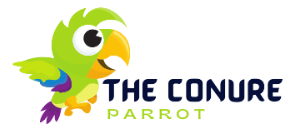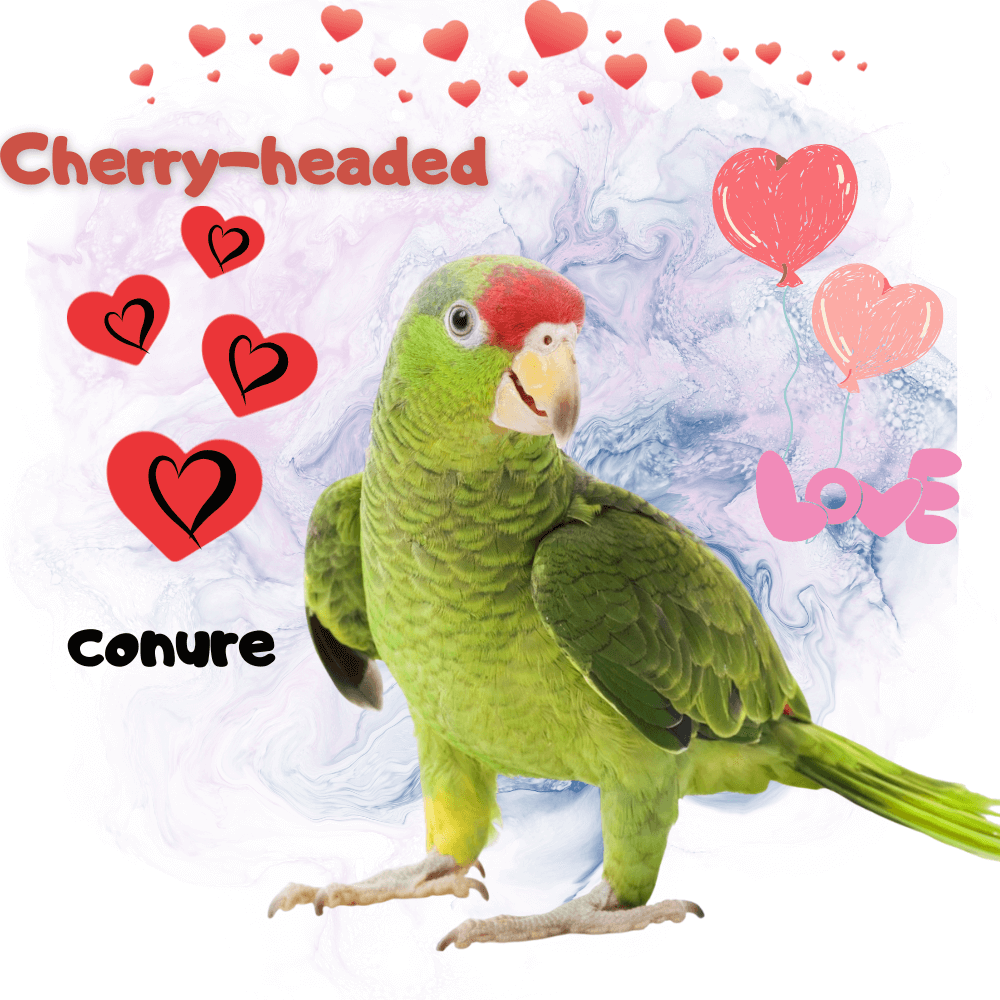The cherry-headed conure, also known as the red-masked conure, is a medium-sized, highly intelligent, and lovable parrot known for its clownish antics. Easy to train, the cherry-headed conure is one of the most talkative birds of the conure species. It also tends to be a noisy bird that is not suitable for apartment dwellers.
Cherry-headed conures are known to be intelligent, fun-loving parrots that thrive on interaction with their owners and do well in training. These birds can be playful, affectionate, and entertaining. Cherry-headed conures love to be the center of attention and go to great lengths to get it.
Like all conures, they are very noisy birds that call intermittently. Although not very talkative, this bird will charm you with its playful personality and comical antics.
The cherry-headed conure, like most parrots, is a flock-oriented bird with well-developed social instincts. In a captive environment, the human owner assumes the role of a herd mate. For a cherry-headed conure to be satisfied, it will need plenty of interaction time with its owner. Properly socialized conures enjoy spending time with (and on) their owners. They like to learn tricks and other training.
Cherry-headed conures need 2-4 hours of exercise and playtime with their owners each day. Once its attention needs are met, you will likely be rewarded with an exciting, interactive pet that never seems to lack energy and drive.
- Scientific name: Aratinga erythrogenys
- Adult size: of11 to 13
- Lifespan:50 years old
Cherry-headed conure habitat
This species mainly lives in jungles and deciduous forests, but it can also grow in semi-arid regions and even in suburban areas.
In several places, pet birds released or escaped into the wild have established wild breeding populations. The movie “The Wild Parrots of Telegraph Hill” popularized a group of wild cherry-headed parrots in San Francisco. Other wild populations exist in other parts of California, Texas, and Florida.
The cherry-headed conure is a very popular pet; in 1994 it was classified as “near threatened” with extinction by the International Union for Conservation of Nature. This status is due to habitat loss and entrapment by the illegal pet trade.
Cherry-headed conure talking
As a group, conures are not talkers like other more articulate parrots. However, the cherry-headed conure is one of the most talkative. He can learn a limited vocabulary. Even a non-talking cherry-headed conure will be extremely talkative with its instinctual vocalizations.
This bird is not well suited to apartment living or owners who are bothered by noise; it is prone to loud calls, especially at sunrise and sunset.
Cherry-headed conure colors
A cherry-headed conure sports dark green feathers over most of its body, with a unique splash of red on its face and head. In some individuals, red spots extend to the neck. The birds also have another patch of red on the top of their wings. They have white rings around their eyes, a horn-colored beak and gray legs. The beauty of this bird makes it a very popular pet.
Caring for a Cherry Conure
The cherry-headed conure should have a roomy cage, at least 24 inches long and 24 inches wide, and 36 inches high. The bars should be no more than one inch apart. Also, provide a playpen outside the cage where the bird can exercise and explore during its daily exercise period.
Make sure you have plenty of drinking water and change it frequently. Cherry-headed conures like to bathe daily and will use a shallow water dish in the cage for this. They also like to be doused with room-temperature water as part of the bathing ritual. This is the perfect time for some much-needed interaction with their human owner. Conures do well in a room-temperature environment but keep them from being in drafty places.
Cherry-headed conures require 10-12 hours of sleep each night in a dark, quiet environment. It may be necessary to cover the cage at night to prevent drafts and light.
Cherry-headed conure health
Common health problems that cherry-headed conures can acquire:
- Conure Bleeding Syndrome: A disease of unknown origin that causes unusual bleeding. The treatment prescribed is usually vitamins.
- Respiratory problems: Usually caused by fungal infections (aspergillosis), fungal respiratory infections can be treated with antifungal medications. You can avoid this serious problem by never letting bedding and food become damp and moldy. Some experts advise never feeding parrots peanuts, which can carry the fungus.
- Bacterial infections: Bacteria can cause respiratory problems and general decline; these infections can be treated with antibiotics. Bacterial infections can be avoided by keeping cages and your bird scrupulously clean.
- Depression: Generally, due to owner neglect, depression can cause destructive behavior and self-harm.
Cherry-headed conure diet
Like all parrots, cherry-headed conures eat a diet of fresh fruits and vegetables supplemented with a high-quality diet of commercial pellets.
You can give them an unlimited amount of food in the form of pellets; they will only eat what they need. For fresh fruits and vegetables, serve them in the morning and evening.
Offer a small amount of seeds as a treat. These birds have a reputation for being addicted to fattening seeds such as sunflower and safflower. Once they attach themselves to these seeds, they may refuse to eat anything else. Overweight birds are prone to a whole host of health issues, so pay close attention to your conure’s diet.
Cherry-headed conure training
Cherry-headed conures are active birds that require 2 hours of daily exercise, of which a minimum of 4 hours is optimal, in a safe, “parrot-proof” outdoor play area. the cage to stay in top shape.
Equip the bird with plenty of toys designed to resist its vigorous chewing habit. Change the bird’s toys frequently to keep it mentally stimulated. Provide perches of different widths inside the cage to allow exercise of the legs.
For
- Social, friendly, and playful nature
- Intelligent, we can teach him things
- One of the most talkative conures
Against
- Noisy bird, not suitable for apartment living or close neighbors
- Requires at least two to four hours of exercise, socialization
Cherry headed conure price
Cherry-headed conures are widely available at pet stores and breeders. Still, it’s always a good idea to check with adoption agencies and rescue organizations to see if they have birds for adoption.
is an organization that maintains a directory of reputable parrot breeders in the United States. If you are considering hiring a bird breeder, be sure to interview the breeder, examine the general health of their birds, check out their living conditions, and talk to their past clients.
Signs you should avoid seeing at the breeder include cramped living conditions, inactive birds, and breeders who avoid your questions or don’t seem to have much information about their birds.
Related article:

